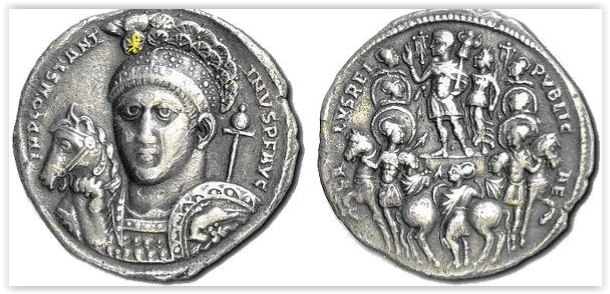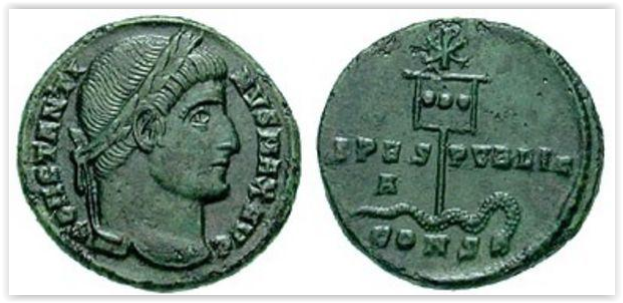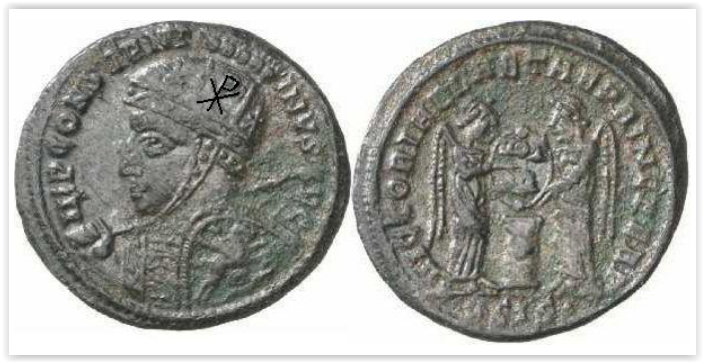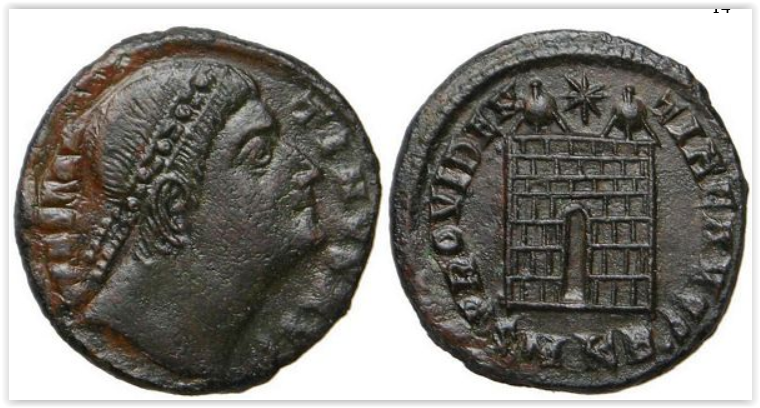Introduction - Part I
In Italy during the fourteenth century some men began to study ancient Roman coins. This should not be a surprise though, as it was the Renaissance, and there was a great interest in the classical past. The humanist Petrarch was the most famous of these early numismatists. Petrarch said in a letter that often people would approach him with a request to identify a newly discovered ancient coin. "Often there came to me in Rome a vinedigger, holding in his hands an ancient jewel or a golden Latin coin, sometimes scratched by the hard edge of a hoe, urging me either to buy it or to identify the heroic faces inscribed on them." 1
At this time, people were mostly concerned with iconography; they mainly wanted to know which emperor was on the front of their coin. A quote from Petrarch illustrates the Renaissance interest in the portraits on the coins. In 1354, Petrarch gave some Roman coins to Emperor Charles IV. "I presented him with some gold and silver coins, which I held very dear . They bore the effigies of some of our rulers - one of them, a most life-like head of Caesar Augustus - and were inscribed with exceedingly minute characters." 2
These early coin collectors would probably be better called antiquarians rather than numismatists. An antiquarian might collect just for the acquisition of old objects, but numismatists study coins in an attempt to answer specific questions that are often historical in nature. In the ensuing centuries however, the field of Roman numismatics grew exponentially.
Iconography is still important, but now the field is a multi-disciplinary endeavor that encompasses many areas such as history, archaeology, and science. Many people have long recognized the importance of numismatics to history, and so me, like the poet W. H. Auden, have argued that coins are more reliable than ancient sources:
Serious historians study coins and weapons
Not those reiterations of one self-importance
By whom they date them,
Knowing that clerks could soon propose a model
As manly as any of whom schoolmasters tell
Their yawning pupils. 3
Of course, coins can be as problematic and prone to bias as written sources, but as long as the numismatist is careful and uses established research criteria, coins can help tell a much fuller story of history.
Introduction - Part II
This paper will look at bronze coins of Constantine the Great, in conjunction with the primary and secondary sources, in an attempt to glean a fuller picture of the past and explore some of the debates that occur in the field of Roman numismatics. Constantine was one of the most (if not the most) influential of the Roman emperors, and his actions and deeds are still affecting people to this day.
Constantine looms large in history, and even in his own time he was impressive, at least according to Eusebius, who said that Constantine was "so exceeding his contemporaries as even to put them in fear... he took pride in moral qualities rather than physical superiority." 4
An interesting question one might ask is, "Without Constantine, would Christianity have flourished?" 5 The answer to that question is outside the scope of this paper, but it helps demonstrate the fundamental importance of his actions. Another important decision Constantine made was turning the city of Byzantium into his new capitol of Constantinople.
So, even though the Western Empire eventually fell, it carried on in the east, as the Byzantine Empire centered at Constantinople. 6 Constantine may have been more responsible for shaping medieval Europe than any other single person. Numismatically, Constantine also made a long-lasting contribution. In A.D. 309, he introduced a unit of currency called the solidus. This gold coin remained in use in the Byzantine Empire until the tenth century. To this day, people are still fascinated with Constantine and his story and myths, and this paper hopes to shed some light on the subject of the significance of this emperor.
As numismatics is a specialized field, this paper will use many numismatic terms that are the jargon of the field, so some of the more common definitions are in order. Ancient Roman coins minted during the fourth century were hand struck by slaves.
Introduction - Part III
Before minting coins though, someone had to make a die. Two dies had to be engraved, the obverse, or front, typically had the bust of the emperor surrounded by the obverse legend which generally consisted of the name of the ruler, and the reverse, or back, which could consist of various types with different messages. 7
Before the minting process, employees prepared metal by melting it and generally they used circular moulds to make coin sized planchets. The engraver made the obverse die so that it would fit into an anvil, while the reverse die looked similar to a large punch. Now the tricky and potentially dangerous part began as one slave held the planchet with a tong between the anvil and punch, while another swung a very large, heavy hammer. The mint workers did this repeatedly, and they managed to turn out a remarkably uniform product. Of course, as these coins were struck by hand, no two would be exactly the same. Using different dies, since they wore out fairly frequently, also meant that there was quite a bit of variety.
After the planchet has been struck, numismatists often refer to the body of the coin as the flan, even though sometimes the term is interchangeable. The specific name of these coins is unknown, but modern numismatists regularly refer to the standard unit of this period as a follis (plural folles). 8 The coins that this paper will deal with have a mintmark in the exergue. This area is located on the reverse of a coin, at the bottom, and is often separated from the rest of the coin by a line.
The mintmark not only tells which city minted the coin, but also which officina in the mint performed the operation. Mint officials divided the mints into different workshops or officinae for efficiency and also for accountability. In the West, Latin, such as P for prima, was used to designate the officina, while the East used Greek, like A for alpha and so on. For example, a coin from Trier might have STR in the exergue, which means that the second workshop (Secunda) in Trier (TR) was responsible, while a coin from Alexandria might have an exergue of SMALB, which translates as sacred money (sacra moneta) from the second (beta) workshop of Alexandria.
This was actually a very efficient and quite orderly system for identification and accountability, and modern U.S. practice continues to utilize mintmarks to distinguish which cities minted particular coins. There may also be various symbols in the exergue, like dots or stars, which help to further separate issues, like dot PTR, which means this coin was from the first officina of Trier. The reverse may also have field marks, which may consist of symbols or letters. These field marks are generally found in the left and right fields of the reverse, mainly to the sides of the main design.
Introduction - Part IV
Numismatists have many reference works for the period that this paper will encompass, but the most commonly cited work will be volume seven of The Roman Imperial Coinage 9, which numismatists commonly abbreviate RIC VII. This book is part of a ten volume set that covers the period of Imperial coinage, from 27 B.C. through A.D. 491. RIC VI, which covers the period from A.D. 294- A.D. 313, has some coins of Constantine's reign, but RIC VII, covering A.D. 313- 337, is the main book for his coinage.
When Patrick Bruun was working on this book, he surveyed major museum collections and the relevant literature in an effort to catalogue the coinage of this period. He arranged it geographically by mint so that it starts in the West with London and ends in the East with Alexandria. Within each city section, the coins are further arranged chronologically.
This book is very technical and Bruun did not write it for the novice; but for the serious numismatist of this period, it is the requisite and authoritative book. Anne Robertson, a noted numismatist, said of this book, "It would be difficult to praise too highly Dr. Bruun's volume, an exquisite piece of work, scarcely marred by a single misprint. It is fortunate that a numismatist of Dr. Bruun's caliber should have been available to carry out so momentous a task." 10
Late Antiquity is currently something of a popular subject in historiography. There is even a new journal, the Journal of Late Antiquity, and the cover of the first volume shows a follis of Constantine, indicating the importance of both Constantine and his coinage. In fact, the first issue had a few articles with a Constantine theme, which also included a few other pictures of coins. However, this journal also shows that there might be a need for greater numismatic knowledge among historians.
One of the pictures shows a common reverse type for the Constantinian period - two soldiers flanking a military standard. 11 The military standard is a little different from most representations of this time though, in that it is inscribed with a chi-rho. The author, or editor, said that this was a coin of Constantine's, and attested to his support of Christianity.
The problem is that the illustrated coin is from Siscia, and this city did not strike these coins with the Christogram until after the death of Constantine. The coin depicted was actually issued by Constantine II (the oldest son of Constantine) after Constantine's death. The Siscian issues confuse many people because after the death of Constantine I, his son Constantine II used the same legends on the obverse as his father had, CONSTANTINVS MAX AVG. The chronology of these coins has long been established, but an easy way to know that the coin is Constantine II is that there are no Siscian issues for Constantine II as Caesar, as he had already assumed the title of Augustus because his father was dead. This might seem like a small issue to some, but God (and Clio) is in the details and history and numismatics are so much better when they are right! History and numismatics are also better if they are entertaining, so let us hope that, besides getting it right, this paper will also entertain the reader.
Christian Symbolism on Coins of Constantine - Part I
According to Eusebius, the fourth century bishop of Caesarea, the first Christian emperor was Philip, who ruled from A. D. 244- 249. 12 The anonymous author of the Origo Constantini also believed that Philip professed to be a Christian, albeit with ulterior motives. "This Constantine was the first Christian Emperor except for Philip (the Arab) who, or so it seems to me, became Christian simply in order that the thousandth year of Rome might be said to belong to Christ rather than to idols." 13
The accounts of the Christian beliefs of Philip were probably just rumors originally started in an attempt to make the emperor look bad, as Christianity was not a very popular religion yet. The first coin with Christian over-tones may have been issued in the name of Salonina, wife of Gallienus, who was the Roman emperor from A.D. 260- 268. There has been speculation that she was a Christian because a coin issued in her name has the reverse inscription AVE IN PACE. 14 There is no historical doubt, however, that Constantine was the first emperor that embraced Christianity though, and this chapter investigates the numismatic evidence of Constantine's conversion.
People who expect to find Christian imagery on bronze coins of Constantine will be disappointed. "Of approximately 1,363 coins of Constantine I in RIC VII, covering the period of 313-337, roughly one percent might be classified as having Christian symbols." 15 The first instance of Christian symbolism on a coin of Constantine is a chi-rho on a rare silver medallion issued from Ticinum in 315. This medallion was not meant for general circulation, but was most likely a special presentation piece, and as such, not many people would have seen it or its design. 16

This coin is important, because it shows a clear chi-rho and was issued shortly after A.D. 312, the year Constantine fought the Battle of the Milvian Bridge. Eusebius even stated that Constantine "was in the habit of wearing on his helmet [the chi-rho] at a later period." 17
Christian Symbolism on Coins of Constantine - Part II
This paper is about the bronze coinage, though, and there is only one bronze reverse that has a symbol associated with Christianity as part of the design. 18 The reverse of this coin has a labarum, which is a military standard topped with a chi-rho, that is piercing a serpent. There are more coins with symbols used as field marks, though.
There is a coin with the reverse legend of VICTORIAE LAETAE PRINC PERP from Siscia that has a chi-rho in the crossbar of Constantine's helmet, but it only occurs a few times, and then only in officina B. There are also the "eyes to the heavens coins", which show Constantine with his head raised up and eyes focused upwards, as if he is looking towards heaven. This bust type is not a solely Christian image, as Greeks used this upward gaze on coins long before Constantine; and the Greek engravers likely meant the bust to show an affinity with the gods.

This bust type is not a solely Christian image, as Greeks used this upward gaze on coins long before Constantine; and the Greek engravers likely meant the bust to show an affinity with the gods. Engravers in the fourth century may have even got the idea for the upraised bust after seeing some of these Greek coins.

The 'eyes to the heavens' bust type was officially issued in bronze in three reverse types. It was used for VOT XXX, and DAFNE types. 19 Sometimes this bust type turns up on CONSTANTINOPOLIS and VRBS ROMA coins, but this was probably more artistic license on the part of the engraver, rather than an official design from the mint. 20

This head uplifted seems to have only been officially engraved by mint personnel from eastern mints, maybe because Constantine was shifting his capitol to Constantinople. Why did mint officials use this bust type? It seems likely that engravers copied this bust from an earlier Greek design, but what, if anything, prompted the use of this type? Eastern mints began issuing this series circa A.D. 325. C onstantine summoned the Council of Nicea in 325 and celebrated his vicennalia (15 year anniversary).
Eusebius tells us this type was issued because of the religious conviction of Constantine:
How deeply his soul was impressed by the power of divine faith may be understood from the circumstance that he directed his likeness to be stamped on the golden coin of the empire with eyes uplifted as in the posture of prayer to God: and this money became current throughout the Roman world. (Eusebius 4:15)
It seems likely that Constantine borrowed this 'eyes to the heavens' pose from Greek coinage and adapted it to convey a Christian message. It could also be that Constantine was sending a message to the Roman world that he was indeed a man of great religious piety.
Footnotes
1Francesco Petrarch,Letters on Familiar Matters XVII- XXIV. Translated by Aldo S. Bernardo (New York: Italica Press, 2005), 57.
2Francesco Petrarch,Petrarch, the First Modern Scholar and Man of Letters; A Selection from His Correspondence with Boccaccio and Other Friends, Designed to Illustrate the Beginnings of the Renaissance. Translated by James Harvey Robinson (New York: Haskell House Publishers, 1970) , 371-372.
3W. H. Auden, quoted in Michael Grant, Roman History from Coins (Barnes & Noble, 1995), 16
4Eusebius, Life of Constantine. Translated by Averil Cameron and Stuart Hall (New York: Oxford University Press,1999) , 77.
5Ramsay Macmullen asked just this question and ultimately said that without state sponsorship it is doubtful that Christianity would have been successful, Christianity & Paganism in the Fourth to Eighth Centuries (New Haven: Yale University, 1997).
6There has been a lot of debate as to whether the Empire fell ( Gibbon's Decline and Fall of the Roman Empire is often cited) or if it was more of a transformation. The concept of transformation was really started by Peter Brown. Recently there have been some historians that convincingly argued that it was indeed a fall. For example-- Peter Heather, The Fall of the Roman Empire: A New History of Rome and the Barbarians (New York: Oxford University, 2006) and Bryan Ward-Perkins, The Fall of Rome and the End of Civilization (Oxford University Press, 2006).
7The actual name of the coins used at this time is unknown, and there are also other names used such as nummus. The word follis was actually a bag used to hold 12,500 denarii, but it is standard practice to call a single coin a follis. For more on this see the article by A. H. M. Jones, "The Origin and Early History of the Follis." The Journal of Roman Studies 49 (1959) : 34-38.
8Patrick Bruun, Roman Imperial Coinage Volume VII: Constantine and Licinius (London, Spink & Son, 1997).
9Anne S. Robertson, "Coins of Constantine and Licinius." The Classical Review 17 (Dec 1967): 377.
10Christopher Haas, "Mountain Constantines: The Christianization of Aksum and Iberia"
11The Journal of Late Antiquity 1 (Spring 2008) : 102. The coin in the picture is credited as one time belonging to Ralph Mathisen, who is the editor of the journal.
12Eusebius, The History of the Church, trans. G.A. Williamson (New York: Penguin Classics, 1990), 206.
13Samuel N. C. Lieu and Dominic Monserrat, From Constantine to Julian: Pagan and Byzantine Views A Source History (New York: Routledge)
14Harold Mattingly, Edward Allen Sydenham, and Percy H. Webb, The Roman Imperial Coinage. Vol. V, Part I(London: Spink & Son, 1927). The Salonina coin is Mediolanum 58.
15Mark Dunning, "First Christian Symbols on Roman Imperial Coins," The Celator 17 ( December 2003) : 6.
16Charles Odahl, "Christian Symbols in Military Motifs on Constantine's Coinage," Society for Ancient Numismatics 13 (1982-3) : 64-72.
17Eusebius, Life of Constantine, trans. Averil Cameron and Stuart Hall (New York: Oxford University Press, 1999) , 81.
18C. H. V. Sutherland, R. A. G. Carson, and Patrick Bruun, The Roman Imperial Coinage. Vol. VII, Constantine and Licinius A.D. 313-337 (London: Spink, 1966) , 572- 3
19VOT is short for votive. Emperors in the fourth century issued these public vows about every five years to celebrate the anniversary of their accession to the throne. So VOT XXX marked the thirty year anniversary of Constantine's rule. Sometimes these coins were anticipatory and actually minted before the real date. This is overly simplified, but for more information on votive coinage see the articles by Harold Mattingly, "The Imperial Vota." Proceedings of the British Academy 36 (1950) : 155-195; and "The Imperial Vota." Proceedings of the British Academy 37 (1951) : 219-268. PROVIDENTIAE AVGG translates as foresight of the emperors. The reverse features a city gate (see figure 5). With this reverse, Constantine wanted to remind his subjects that they were safe and secure due to his actions. The DAFNE (Dafne is Greek for victory) coins will be talked about at length in chapter two of this paper.
20CONSTANTINOPLIS (Constantinople) and VRBS ROMA (City of Rome) coins were issued starting in A.D. 330 and continued until A.D. 346. These were issued to mark the foundation of Constantinople and to also re-affirm Rome as the traditional center of the Empire. This paper will discuss these coins more in chapter two. The reason that the use of the uplifted head on some of these must have been unofficial, is that the normal bust occurs at the same time and from the same mint and same officina. These coins also come from Eastern mints, which had more Hellenistic influence, which goes back to the point that the Greeks originally used th e uplifted gaze on coins before the Romans.
